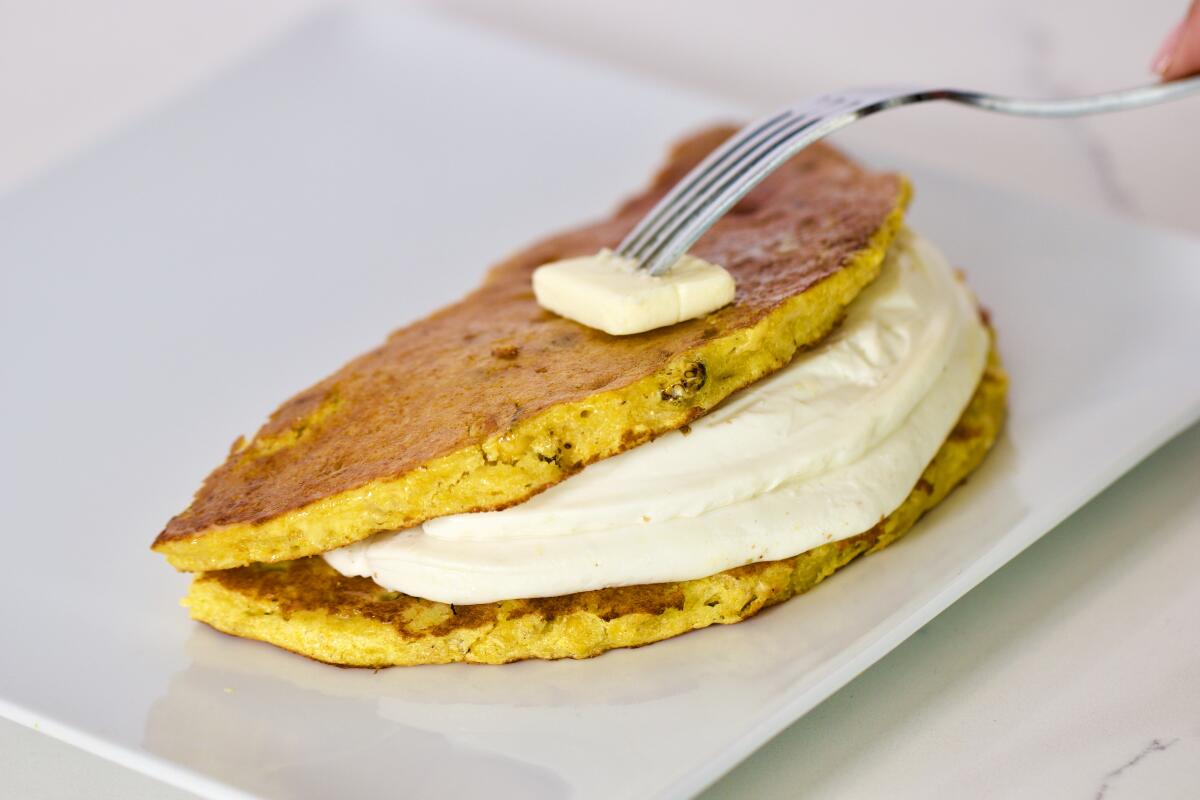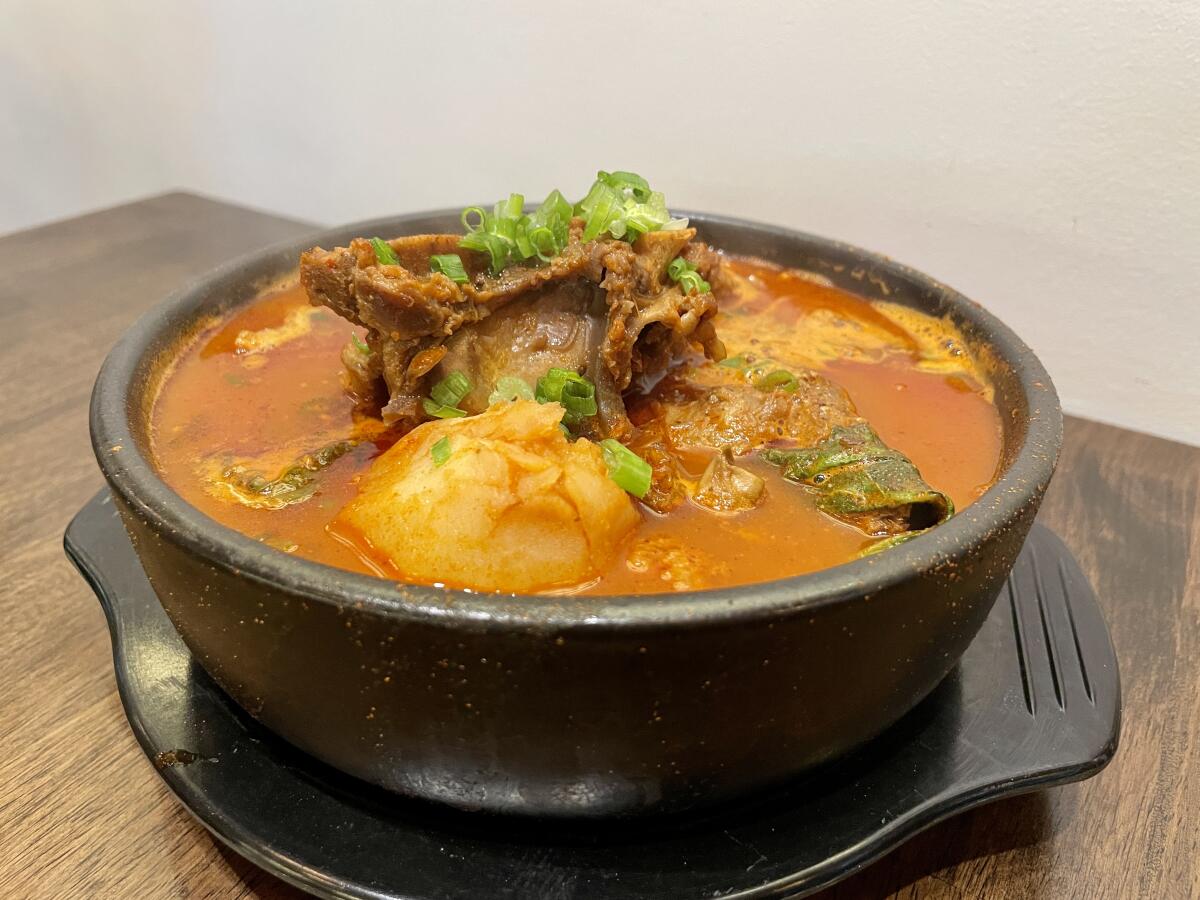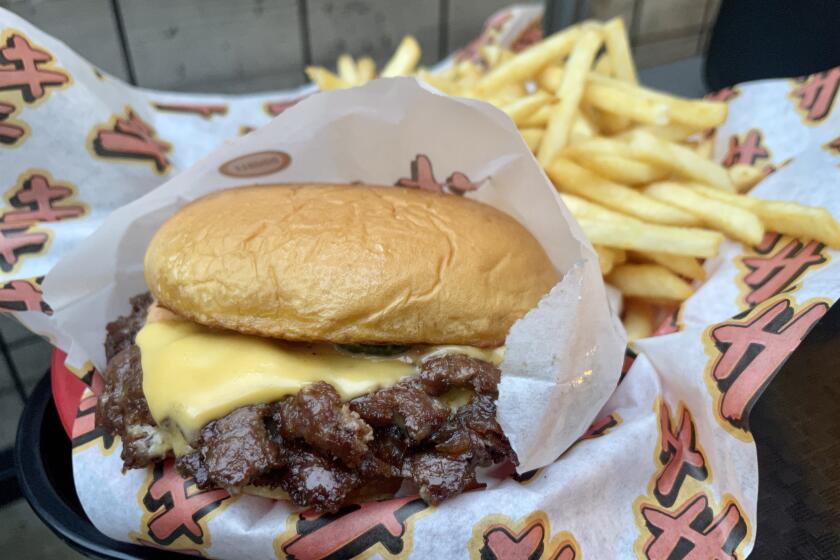Venezuelan pancakes are better than American pancakes. Full stop

This week’s column is devoted to comfort food in the form of Venezuelan pancakes and hot pots of Korean pork bone stew.
Cachapas at Amara Cafe
The classic American pancake breakfast does nothing for me. It never has. Turns out, I was just eating the wrong kind of pancakes for breakfast.
The cachapa is the pancake for me. The Venezuelan corn cakes are the crown jewel of pancakes. Thin, crisp round disks taste of nothing but sweet, toasted corn. This is something Amara Barroeta has known since she was a child. She spent many mornings eating cachapas from the vendors that line the highways near her hometown of Los Teques, the capital city of Miranda in Venezuela. There, Barroeta says, vendors serve corn pancakes the size of truck tires, hot off the griddle and stuffed with cheese. (Fun fact: Barroeta was named first runner up in the 2002 Miss Venezuela pageant.)
When Barroeta decided to add them to the menu at Amara Café, her restaurant in Old Pasadena, she wanted to create something that tasted like the many breakfasts eaten by the highway. But first, she needed to find the right ingredients.
“It took about a year of researching corn to find the right vendor because the corn here, the level of sweetness is high but the water content is also high,” she said. Barroeta tapped into the skills she learned while studying chemical engineering with an emphasis in food science at an engineering school in Venezuela. “Cachapas don’t have eggs in Venezuela, but with the corn here, we added eggs for the consistency.”
This week’s recommendations include a new smash burger and chocolate-dipped cones in Santa Monica, lunch at Coni’Seafood in Inglewood and Indian skewers in the clay oven in Alhambra.
Barroeta grills her corn before adding it to her batter to absorb some of the moisture and to add a roasted flavor. The pancakes are browned on both sides with crisp, mishapen edges that almost make them look like fritters. You can order your cachapa filled with queso fresco or queso de mano. The latter is how Barroeta eats her cachapas back home, with a fat slice of the cheese stuffed into the middle.
From across the table, the stark white cheese might look like folds of whipped cream, but it’s a slab of mild cheese with a slight tang and the firmness of good, fresh mozzarella. She sources the cheese, along with nata, a salted sour-cream-like condiment she serves alongside the cachapas, from a cheesemaker in Miami.
If you order the galipan cachapa, your pancake will come with a side of eggs, black beans and a stewed meat of your choosing (or bacon or avocado).
“We serve it like you’re at home in Venezuela with a bunch of sides so you can choose what you want on your plate,” she said. “Ourselves and other Venezuelan restaurants and organizations are just trying to preserve our culture. Food is one of the things that unites us, and when one or two generations stop cooking these dishes, it’s basically lost.”
The plate is named after Galipan, a town in northern Caracas in El Ávila National Park, where Barroeta said people often hike. Her cachapas are just the sort of thing you could eat after a morning trek up a mountain. I’ve never been much of a hiker, but I’ll happily climb a hill or two for some cachapas.
Gamjatang from Gamjatop

Gamjatang is a one-bowl-wonder. Luxury and comfort in a roiling red stew. It is the only entrée at Gamjatop, where depending on the size of your order, your bowl may be as wide as the table, with a massive pile of pork bones in the center.
Chef and owner Jihoon Choi opened his San Gabriel restaurant earlier this year. Choi, who is from Seoul, learned how to make the stew from his mother, though he says it’s not a dish you can easily cook at home. The stew takes hours to make, starting with the preparation of the bones. The pork bones are soaked in water for the equivalent of a full workday to remove excess blood, then they’re blanched in boiling water. Choi adds soybean paste and his secret blend of “Korean spices” and lets the mixture boil with the bones for another couple of hours.
Then he adds potato, enoki mushrooms, perilla leaves that darken and mellow in the soup and perilla seed powder. The entire process takes about 12 hours.
The first steaming sip is a shock to the senses, with a burst of sharp, salty umami and chile. It’s also served hot. Really hot, with the soup sputtering as it hits the table. On a recent visit, everyone in the small dining room, including myself, seemed to be sweating as they slurped away. I hunched my shoulders and stooped over my bowl, using my chopsticks to meticulously pull away the scraps of meat on my bones. I dipped them into the small ramekin of nose-tingling, cloudy hot mustard sauce that Choi serves with the stew.
Gamjatop’s gamjatang is milder in both spice and color than the rufous red stew at Ham Ji Park in Koreatown, and not as heavily adorned as the one at Gamjatang House in Garden Grove, where the stew is cloaked under a jumble of perilla leaves. But it has that rich, carnal quality present in all good gamjatang. And the heat creeps in slowly, building as you sip.
You could tell which tables ordered the gamjatang combo, served with steamed eggs, noodles and ice cream sandwiches. I opted for an a la carte gamjatang and a seafood pancake and continued to sweat as I dunked my scallion-studded slices into the soup.
Restaurants featured in this story.
Amara Cafe, 55 S. Raymond Ave., Pasadena, (626) 744-1765, amaracafe.com
Gamjatop, 416 E. Las Tunas Dr. Ste E, San Gabriel, (626) 872-1748, www.gamjatopusa.com
More to Read
Eat your way across L.A.
Get our weekly Tasting Notes newsletter for reviews, news and more.
You may occasionally receive promotional content from the Los Angeles Times.










